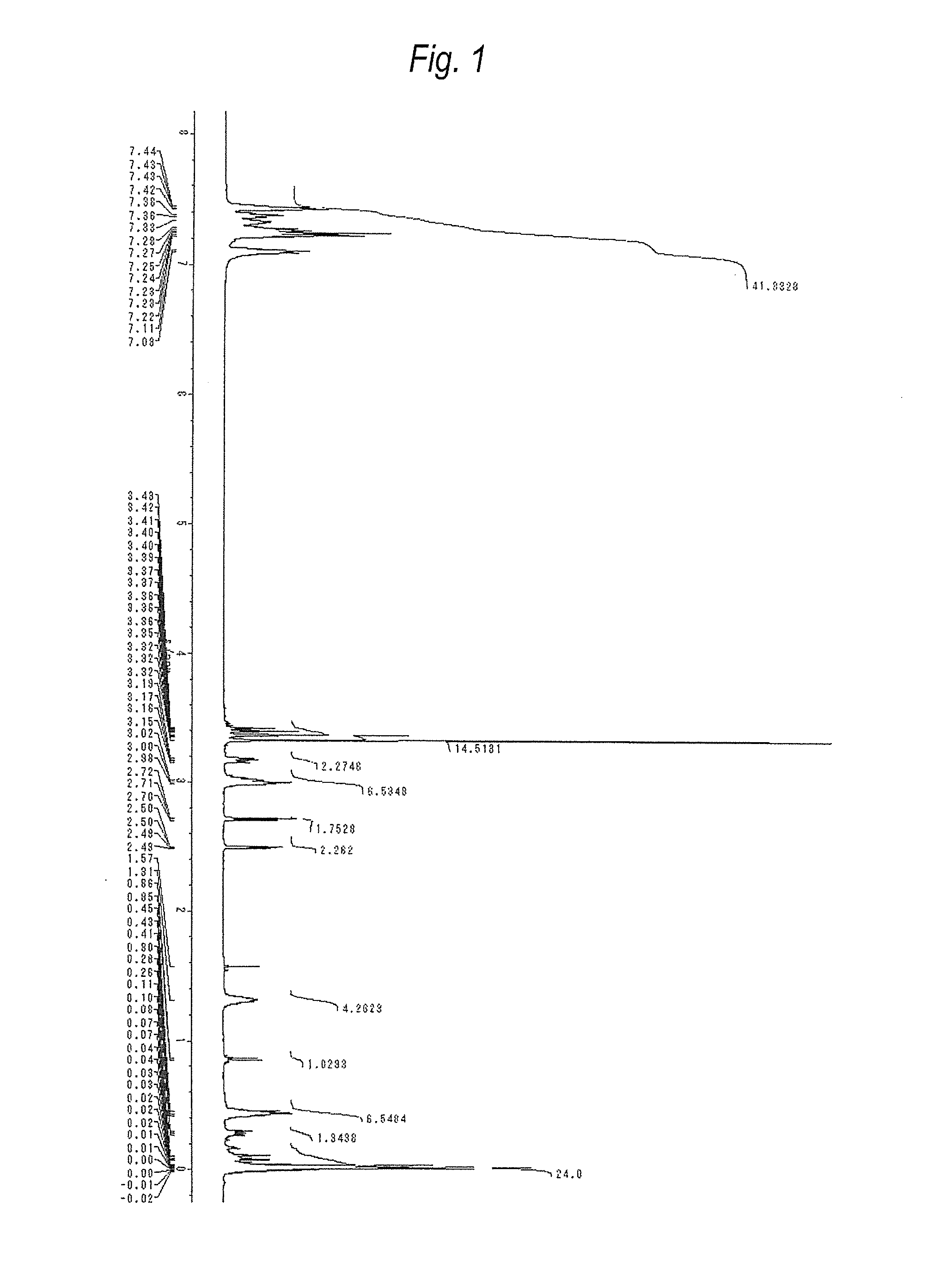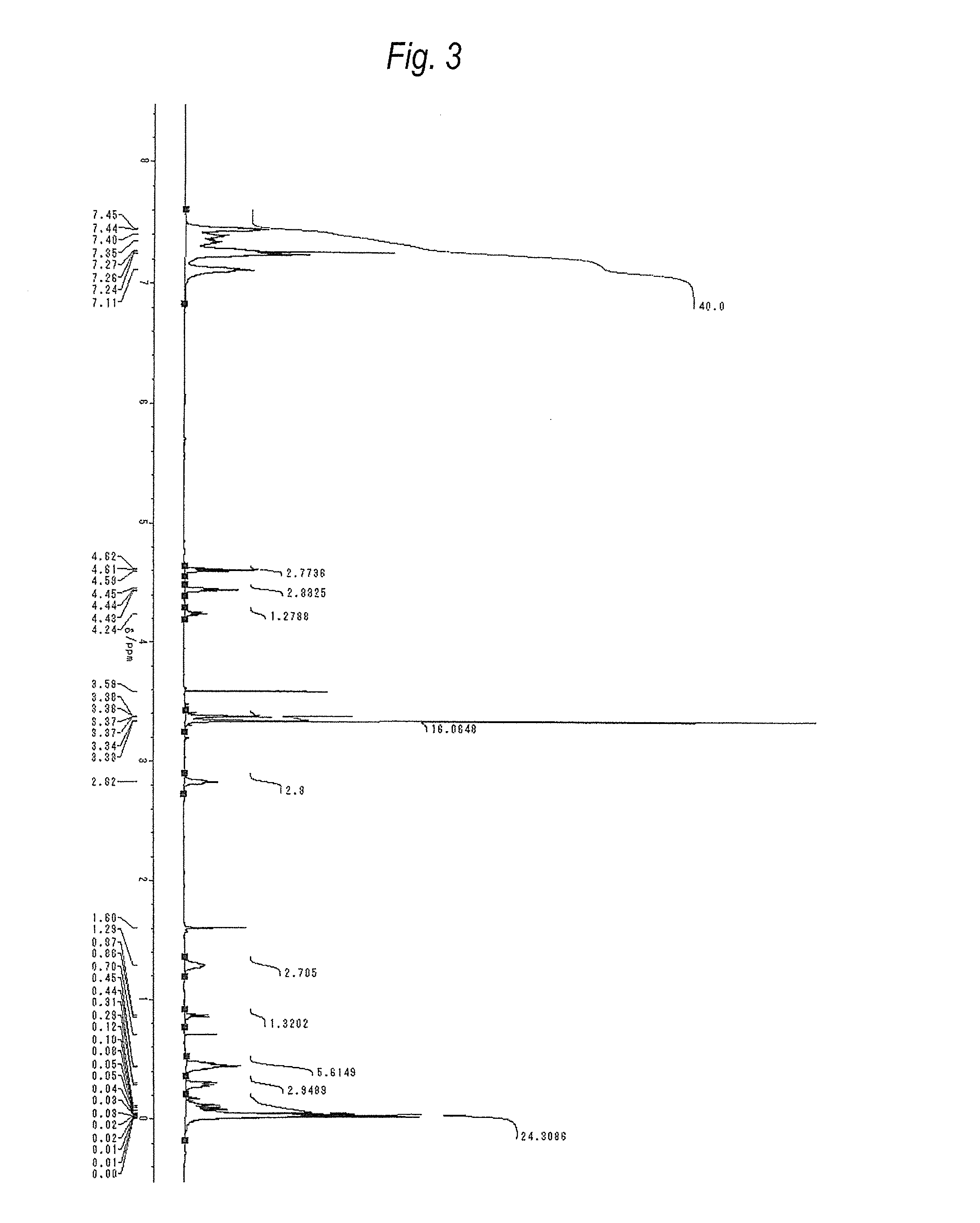Epoxy and alkoxy silyl group-containing silsesquioxane and composition thereof
- Summary
- Abstract
- Description
- Claims
- Application Information
AI Technical Summary
Benefits of technology
Problems solved by technology
Method used
Image
Examples
synthesis example 1
[0200]Compound (A1) was produced according to the following formula.
[0201]In a nitrogen atmosphere, a reaction vessel equipped with a thermometer, a dropping funnel and a reflux condenser and having an inner volume of 300 mL was charged with compound (a-1-1) (150 g) synthesized by the method disclosed in International Publication No. 2004 / 024741 and dry toluene (210 g), and sealed with dry nitrogen. The contents were heated under stirring with a magnetic stirrer to a reaction temperature of 100° C.
[0202]A Pt catalyst (13 μL) was added using a microsyringe, and allyl glycidyl ether (43 g) produced by Tokyo Chemical Industry Co., Ltd. was slowly added dropwise from the dropping funnel, followed by stirring for 2 hours. Furthermore, a Pt catalyst (92 μL) was added, and Silaplane S210 (trade name) (26 g) produced by JNC Corporation was added, followed by stirring for 2 hours. After cooling, activated carbon at 3 mass % was added to the crude product, and the resulting mixture was stirre...
synthesis example 2
[0204]Compound (A2) was produced according to the following formula.
[0205]In a nitrogen atmosphere, a reaction vessel equipped with a thermometer, a dropping funnel and a reflux condenser and having an inner volume of 500 mL was charged with compound (a-1-1) (130 g) synthesized by the method disclosed in International Publication No. 2004 / 024741 and dry toluene (130 g), and sealed with dry nitrogen. The contents were heated under stirring with a magnetic stirrer to a reaction temperature of 100° C.
[0206]A Pt catalyst (100 μL) was added using a microsyringe, and allyl glycidyl ether (11 g) produced by Tokyo Chemical Industry Co., Ltd. was slowly added dropwise from the dropping funnel, followed by stirring for 2 hours. Subsequently, Silaplane 5210 (trade name) (59 g) produced by JNC Corporation was added, followed by stirring for 3 hours. After cooling, activated carbon at 3 mass % was added to the crude product, and the resulting mixture was stirred at room temperature through the n...
synthesis example 3
[0208]Compound (A3) was produced according to the following formula.
[0209]In a nitrogen atmosphere, a reaction vessel equipped with a thermometer, a dropping funnel and a reflux condenser and having an inner volume of 500 mL was charged with compound (a-1-1) (200 g) synthesized by the method disclosed in International Publication No. 2004 / 024741 and dry toluene (200 g), and sealed with dry nitrogen. The contents were heated under stirring with a magnetic stirrer to a reaction temperature of 100° C.
[0210]A Pt catalyst (60 μL) was added using a microsyringe, and allyl glycidyl ether (58 g) produced by Tokyo Chemical Industry Co., Ltd. was slowly added dropwise from the dropping funnel, followed by stirring for 5 hours. Subsequently, Silaplane S210 (trade name) (46 g) produced by JNC Corporation was added, followed by stirring for 3 hours. After cooling, activated carbon at 3 mass % was added to the crude product, and the resulting mixture was stirred at room temperature through the ni...
PUM
| Property | Measurement | Unit |
|---|---|---|
| Carbon number | aaaaa | aaaaa |
| aaaaa | aaaaa |
Abstract
Description
Claims
Application Information
 Login to View More
Login to View More - R&D
- Intellectual Property
- Life Sciences
- Materials
- Tech Scout
- Unparalleled Data Quality
- Higher Quality Content
- 60% Fewer Hallucinations
Browse by: Latest US Patents, China's latest patents, Technical Efficacy Thesaurus, Application Domain, Technology Topic, Popular Technical Reports.
© 2025 PatSnap. All rights reserved.Legal|Privacy policy|Modern Slavery Act Transparency Statement|Sitemap|About US| Contact US: help@patsnap.com



